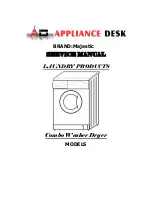
4
English
1
SAFETY INSTRUCTIONS
1.1
The appliance you have purchased is a technologically advanced
product designed by one of the leading European manufacturers
of high pressure pumps. To obtain the best performance from your
unit, read this booklet carefully and follow the instructions each
time you use the it. We congratulate you on your choice and wish
you successful operation.
2
SAFETY RULES/RESIDUAL RISKS
2.1
SAFETY “MUST NOTS”
2.1.1
DO NOT use the appliance with
inflammable or toxic liquids, or
any products which are not compatible with the correct operation
of the appliance.
E
XPLOSION OR POISONING HAZARD
2.1.2
DO NOT direct the water jet towards people or
animals.
I
NJURY HAZARD
2.1.3
DO NOT direct the water jet towards the unit
itself, electrical parts or towards other electrical
equipment.
E
LECTRIC SHOCK HAZARD
2.1.4
DO NOT use the appliance outdoors in case of rain.
S
HORT
CIRCUIT HAZARD
2.1.5
DO NOT allow children or incompetent persons to use the
appliance.
I
NJURY HAZARD
2.1.6
DO NOT touch the plug and/or socket with wet
hands.
E
LECTRIC SHOCK HAZARD
2.1.7
DO NOT use the appliance if the electrical cable is
damaged.
E
LECTRIC SHOCK AND SHORT CIRCUIT HAZARD
2.1.8
DO NOT use the appliance if the high pressure
hose is damaged.
E
XPLOSION HAZARD
2.1.9
DO NOT jam the trigger in the operating position.
A
CCIDENT
HAZARD
2.1.10
Check that the data plates are affixed to the appliance, if
not, inform your dealer. Units without plates must NOT
be used as they are unidentifiable and potentially dangerous.
A
CCIDENT HAZARD
2.1.11
DO NOT tamper with or adjust the setting of the
safety valve or the safety devices.
E
XPLOSION HAZARD
2.1.12
DO NOT alter the original diameter of the spray head
nozzle.
H
AZARDOUS ALTERATION OF OPERATING PERFORMANCE
2.1.13
DO NOT leave the appliance unattended.
A
CCIDENT HAZARD
2.1.14
DO NOT move the appliance by pulling on the
ELECTRICAL CABLE
.
S
HORT CIRCUIT HAZARD
2.1.15
Make sure that cars do not drive over the high pressure hose.
2.1.16
DO NOT move the appliance by pulling on the high pressure hose.
E
XPLOSION HAZARD
2.1.17
When directed towards tyres, tyre valves or other pressurised
components, the high pressure jet is potentially dangerous. Do not
use the rotating nozzle kit, and always keep the jet at a distance of
at least 30 cm during cleaning.
E
XPLOSION HAZARD
2.2
SAFETY “MUSTS”
2.2.1
All electrical conductors MUST BE PROTECTED against the
water jet.
S
HORT CIRCUIT HAZARD
2.2.2
The appliance MUST ONLY BE CONNECTED to an
adequate power supply in compliance with all
applicable regulations (IEC 60364-1).
E
LECTRIC SHOCK HAZARD
• Use of a safety residual current circuit-breaker (R.C.C.B.) will
provide additional protection for the operator (30 mA).
Models supplied without plug must be installed by qualified staff.
Use only authorized electrical extension leads with suitable
conductor gauge.
2.2.3
High pressure may cause parts to rebound: wear all the protective
clothing and equipment needed to ensure the operator’s safety.
I
NJURY HAZARD
2.2.4
Before doing work on the appliance, REMOVE the plug.
A
CCIDENTAL START
-
UP HAZARD
2.2.5
Before pressing the trigger, GRIP the gun firmly to
counteract the recoil.
I
NJURY HAZARD
2.2.6
COMPLY WITH the requirements of the local water
supply company. According to EN 12729 (BA), the
appliance may only be connected to the mains drinking water
supply if a backflow preventer valve with drain facility is installed in
the supply hose.
C
ONTAMINATION HAZARD
2.2.7
Maintenance and/or repair of electrical components
MUST be carried out by qualified staff.
A
CCIDENT HAZARD
2.2.8
DISCHARGE residual pressure before disconnecting the
unit hose.
I
NJURY HAZARD
2.2.9
Before using the appliance, CHECK every time that the
screws are fully tightened and that there are no broken or
worn parts.
A
CCIDENT HAZARD
2.2.10
ONLY USE detergents which will
not corrode the coating materials
of the high pressure hose/electrical cable.
E
XPLOSION AND ELECTRIC
SHOCK HAZARD
2.2.11
ENSURE that all people or animals keep a
minimum distance of 16 yd. (15m) away.
I
NJURY
HAZARD


































